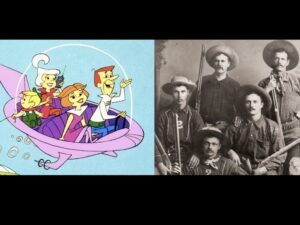
If you had to choose to live in 3075 or 1875, which would you pick, and why?
What do you think you’d find there?

by James Scott Bell
@jamesscottbell
I left a comment on the first-page Kris critiqued last Tuesday. I suggested the author eschew backstory and exposition, except what was put into confrontational (as opposed to expositional) dialogue. Kris asked if I might expand on that.
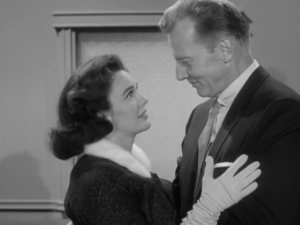
Patricia Medina and Bruce Bennett in “The Case of the Lucky Loser.”
First, let’s define terms. Exposition is information, stuff a reader needs to know in order to fully understand what’s going on in a scene and, indeed, the whole book. The key word here is needs. A common mistake, especially in opening pages, is too much exposition in the narrative. That was the problem with the manuscript Kris critiqued. It had a couple of long paragraphs of pure information (an “info dump”). The author thought them necessary for readers to understand what was going on. Not so. Readers will wait a long time for full exposition if they’re caught up in a tense scene. My standard advice is Act first, explain later.
Yet sometimes a bit of backstory or exposition is called for, and the best way to deliver that info is through dialogue. But it has to be confrontational and sound like it’s really two characters saying what they would say in that situation.
Let me demonstrate with an example. In many TV dramas of the 50s and 60s, the set-up was sometimes larded with dialogue that sounded forced, that was there just to give the audience information. Here’s a bit from the old Perry Mason series starring Raymond Burr. In “The Case of the Lucky Loser” we open with a man and woman in a train compartment:
HARRIET: I still wish I were going to Mexico with you instead of staying here in Los Angeles.
LAWRENCE: This trip’s going to be too dangerous, Harriet. It’s some of the most rugged terrain in the Sierra Madre mountains. It’s no place for a woman, especially my wife. It’s almost no place for an amateur archaeologist, either. Thanks for coming with me as far as Cole Grove Station.
Yeesh! What’s wrong with that is called “the false triangle.” The dialogue should sound like two characters talking to each other, like this:

But when the author tries to “cleverly” send the reader information, the transaction looks like this:
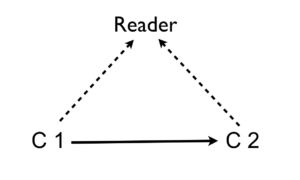
The solution is simple: Make the dialogue confrontational. That doesn’t mean it has to be a big argument, though that always works. Just insert enough opposition so there’s some tension. The Perry Mason example could go like this:
“Let me come with you,” Harriet said.
“That part of Mexico’s too dangerous,” Lawrence said.
“It’s dangerous in L.A., too, unless you haven’t noticed.”
Lawrence laughed and stroked her hair. “The Sierra Madres are no place for—”
“If you say a woman again I swear I’ll file for divorce.”
“Honey—”
“You’re an insurance salesman, not an archaeologist! The only rocks you should be looking at are in your head.”
“Now, now.” Lawrence looked out the window. “We’re coming into Cole Grove Station.”
“Don’t make me get off,” Harriet said.
“See you in two weeks,” Lawrence said.
Find any dialogue in your manuscript where you’ve slipped into the “false triangle.” Transform that conversation into confrontation. Then look for places where you’ve dropped a paragraph or more of raw exposition. Cut out any information that can wait until later, and see if you can put what’s left into a conversation between two characters.
Say, why don’t we try it now? Here’s a bit of expositional dialogue. Show us in the comments what you can do to make it confrontational:
There was a knock at the door. Molly opened it.
“Well hello, Frank,” Molly said. “What brings my favorite accountant all the way out here to Mockingbird Lane?”
“Hi, Molly,” Frank said. “I wonder if we might have a chat about your tax return for last year, when you got that $35,000 advance on your first novel, When the Wind Whips, from Simon & Schuster. Who says an author has to be in her twenties or thirties to start a career, eh? May I come in?”
“Sure,” Molly said, opening the door for him.
“You could have called,” Molly said. “I would have been happy to drive my Tesla to your office where my friend, Linda, is your receptionist.”
“That’s all right,” Frank said. “I need to take off a few pounds as you can see, so the walk did me good.”
Have fun!

Sir Elton John, Wikimedia Commons
Sir Elton John has retired from the road. I’m a fan of his Bernie Taupin era, saw him in concert twice. I was in high school when his first hit, “Your Song,” came out. Which prompts today’s question: If you had an intro song that played every time you walked into a room, what would it be?
by James Scott Bell
@jamesscottbell
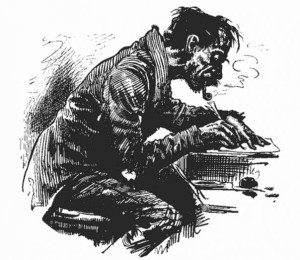 Back when I was trying to learn how to write fiction, I joined the Writer’s Digest book club. Each month I’d buy a book or two, devour them, try things out. I have several shelves filled with these books, all highlighted and sticky-noted. Every now and then I like to take one down for a revisit, remembering the lessons I learned.
Back when I was trying to learn how to write fiction, I joined the Writer’s Digest book club. Each month I’d buy a book or two, devour them, try things out. I have several shelves filled with these books, all highlighted and sticky-noted. Every now and then I like to take one down for a revisit, remembering the lessons I learned.
I recently did that with a tome from 1992, The Writer’s Digest Handbook of Novel Writing. It’s a collection of advice from a number of published authors. On the flyleaf I had written five things from the book I especially wanted to remember. Let’s have a look and see if they still apply!
The advice here, from W. C. Stroby, is simple:
Write a story that excites you, challenges you, that keeps you awake at night every time you start to think about it. If you can’t get fired up over it, who will?
“Some books I’ve written come to me because I’ve seen something in the paper that out rages me,” Says Robert Campbell. “A lot of them come out of a philosophical position that is cooked in my mind for many years, until I found the story to tell it. Either way, it has to be something that, in a sense, demands my attention.”
I’ve tried to follow this advice ever since. Whenever I conceive of an idea that might have commercial value, I don’t start writing until I make an emotional connection with the material. I made a Venn diagram for myself which looks like this:
That’s the sweet spot. You can be jazzed as all get out about an idea, but unless you’re going for the obscure genius profile, you need to find a commercial connection. On the other hand, you may think up a high concept for the market, but you then need to work it until the jazz starts up in you, lest you end up writing something “by the numbers.”
Verdict: Still applies.
The great Dwight Swain contributed this chapter. He’s not, of course, advocating always opening with dialogue. But he does cite a pulp editor who told him, “Always open with dialogue, because when two people are talking, they have to be talking about something—something your readers can understand without a lot of explanation.”
Opening with dialogue is a great way to combat throat clearing and info dumping in the first pages. Dialogue automatically makes you write a scene.
The standard criticism you hear (“You can’t open with dialogue because we don’t know enough about who’s talking!”) is the bunk. Readers will wait a long time for info if they’re listening to taut, tension-filled dialogue.
Verdict: Still works.
That’s my own term, which I came up with via the same Swain chapter. He advised striving for the “provocative line.”
Hunt for at least occasional new, fresh, original ways for your characters to say whatever it is they have to say. In their proper places, slang, colorful analogies, personification, and the like can prove very effective….Just don’t carry it so far that your readers label it as straining for effect.
Thus I made it a goal to put a colorful line of dialogue (a “gem”) in each act of the book.
Verdict: Why wouldn’t you?
Swain’s disciple, Jack Bickham, wrote a chapter on scene and sequel. “For dramatic reasons,” he said, “you can withhold information from your readers for a while” making them eager to read on.
An example is when you write in multiple 3d Person. You finish a scene with a disaster for POV 1. How will he get out of this? Instead of showing that next, you cut over to POV 2. Get that POV trapped, and go back to POV 1 or hop over to POV 3! Make ’em wait and turn those pages! This is how I like to do my stand alones, such as Your Son is Alive and Can’t Stop Me.
But what if you write in First Person, as I do in my Mike Romeo series? Here I learned a neat trick from Bickham, what I call the “time jump.” Bickham says he got it from the famous mystery writer Phyllis Whitney, who always wrote in First.
What you do is get to the end of a scene where something major (a setback or shock) happens, or is about to happen. The reader expects the next scene to be about the character’s reaction. But no! You jump ahead in time to another scene, which is about something else entirely. As the reader keeps reading to find out what the heck happened in the last scene, you keep them waiting until a moment when your narrator recounts to another character what the reaction was. They will turn those pages to find out!
With Romeo, since he’s a philosopher who can also beat people up, I’ll sometimes bring him to the brink, when he’s about to be set upon by one or more thugs. Instead of going immediately into the fight, Mike will recall a philosophical point or historical moment that somehow has relevance to what is about to happen. He loves gardening, too, so he may talk about plant life before commencing to blows.
Yes, it’s manipulation, but when you do it well, readers love it.
Just don’t overdo it.
Verdict: Requires skill, but when you pull it off, it’s aces.
Russell Galen’s chapter is called “How to Chart Your Path to the Bestseller List.” He writes:
Editors are buying you, not just your manuscript. They want to be convinced you’re dedicated to becoming successful; that you have more than one book in you; that your current work is better than your past work, and that your future work will be even better; that you’re looking for a publishing relationship, a long-term home for your work, and not just a deal…Don’t boast that you can write a novel in eleven days—as one writer did to me recently—when editors are looking for evidence that you take pains to make each book as good as it can possibly be.
This was obviously written in the trad-only days, but the advice is just as sound for indies. Readers are looking for new favorite authors, not just books, and if you give them less than stellar work, they won’t stick around waiting for you to measure up. If you want a career out of this, as opposed to a hobby throwing wet spaghetti at the wall, put your work through a grinder.
As Dorothy Bryant puts it later in the book, “Anyone can do a rough draft….The difference between ‘anyone’ and a serious writer is rewriting, rewriting, and grinning over gritted teeth.”
Verdict: If you want to sell widely, pay heed.
Discuss!
by James Scott Bell
@jamesscottbell
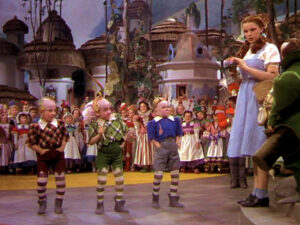 I love this place.
I love this place.
Remember when sepia-tone Dorothy opens the door of her transported house, and sees a strange world of vivid colors, striking flora, and giggling Munchkins? We are not in Kansas anymore!*
What adventures await? What discoveries? And dangers! Good witches and bad witches, trees that throw their fruit, lions, tigers and bears. Oh my!
Well, that’s how I feel at the beginning of a project. I’m in a land of infinite possibilities and not wedded to any of them. I get to explore. I take a stroll down a yellow-brick road and come to a fork. “Some people do go both ways,” a friendly scarecrow tells me. Off I go one way, taking notes. I decide to go back and take another way. Takes me a millisecond to get to another setting entirely. More notes and ideas for plot, characters, twists, turns and settings.
I call this my “white hot document.” I’m recording what ifs and what nows as fast as they come to me. I don’t settle on one direction just yet.
The next day I come back for more. I annotate the notes, highlighting what still excites me, and go off again. I add more characters, scene ideas, plot possibilities. Lather, rinse, repeat.
After a week or so the story I really want to tell—or, more accurately, the story that wants me to tell it—begins to take shape.
This is the most enjoyable part of writing for me. The world is my oyster and there are pearls all around.
Now the work begins. I start to lay out my scene cards (in Scrivener), concentrating on my signpost scenes. Especially my Mirror Moment, which becomes the beam of light that helps me navigate the story from opening Disturbance, through the Doorway of No Return, to the final Transformation. I’m still having fun.
Then comes the writing, which sometimes flows (lots of fun), sometimes slogs (ack). But either way, I make sure the word quota gets done. There’s always satisfaction in that.
Finally, I get to the end. I work on this part the most, the last fifty pages. I know I’ve hit the mark when emotions kick in. Elation, deep satisfaction, sometimes laughter, sometimes tears.
Yes, I’ll admit it. I have on more than one occasion experienced the waterworks when I hit just the right note of resonance. Like when I typed the last line of Try Fear. It was the end of my Ty Buchanan legal thriller trilogy. I’ve had a consistent stream of emails asking me to continue this series, but I am loath to mess with what I consider my most perfect ending.
I set the first draft aside for a few weeks.
Then comes the first read-through, in hard copy. I don’t particularly enjoy this part, but know it’s make things better. I make my revisions, then give it to my first reader, the sainted Mrs. B.
This is the hard part! Waiting for her notes, then going through the book with her page by page. It’s like surgery. Nobody chooses surgery as a fun activity, but you take it when you know it will make you healthier. Ditto your book.
And then you’re in recovery which is, for me, the final polish. The last tinkering, usually with dialogue and scene endings.
Proof reader next. Then, finally, out the book goes to the world. This is really enjoyable as an indie, because I don’t have to wait a year for the book to hit the shelves. Thus, launch day is champagne day. I pop a bottle for my wife and me, and usually cook up a rib-eye on the barbie, to be enjoyed with a nice cabernet.
I awaken the next day, and open the door to a new world of vivid colors…
What’s your favorite part of the writing process? The least favorite? How do you treat yourself when your book is finally published?
*Bonus Note: How did The Wizard of Oz pull off the effect of Dorothy opening the door in B&W to reveal a Technicolor world? It was ingenious for the day. The entire scene was shot in color! The interior of the house was painted in sepia tones, and “Dorothy” was really Judy Garland’s stand-in, in a sepia dress, black wig, and dark makeup on the arms. Notice that she pulls the door open, revealing the colorful world, and backs out of the shot. That’s when Judy Garland moves into the scene, carrying a fake Toto. Watch:
by James Scott Bell
@jamesscottbell
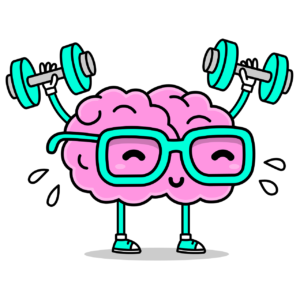 I’ve often thought of the imagination as a muscle. With proper care and exercise, it gets stronger. Leave it alone, and it atrophies.
I’ve often thought of the imagination as a muscle. With proper care and exercise, it gets stronger. Leave it alone, and it atrophies.
For fiction writers, the imagination is our stock-in-trade. The healthier it is, the more likely the production of fresh, original writing.
One of the best exercises for the imagination is the “What if” game. Through daily practice you train yourself to ask “What if X?” in response to the stimuli—usually visual—that come your way in an ordinary day.
You’re driving and come to a stoplight. What appears to be an elderly woman pushing a shopping cart stuffed with belongings enters the crosswalk. Are things just as they appear? Probably. But not to your creative mind! So you ask:
What if there’s a bomb in that shopping cart?
What if the lady is the heiress of a large fortune, but went insane? Or was driven insane?
What if it is really a man in disguise and he’s on the down low because a contract has been put out on him?
The light turns green and off you go, letting the ideas simmer in your brain.
You pass a billboard of a happy family—smiling dad and mom, two laughing kids—at a theme park. Happy to most people, maybe. But:
What if Dad is a hit man on the side?
What if Mom is the assassin-for-hire?
What if one of the kids is an alien?
Two minutes have gone by and you already have six or seven ideas.
If you’re diligent about this exercise, your imagination muscle will churn all the time, often without conscious thought. Then the issue won’t be, Where do I find my next idea? but, How do I choose from all the great ideas my imagination has already provided?
As I look back at my own books, I think I can safely say that most of the ideas sprang from a What if conjecture. Sometimes that was the product of just sitting down and telling myself to come up with something. Several times it was me riffing off some odd news item.
Like an L.A. story that haunted me for a few years. A man shot his wife, drove to a freeway overpass, got out of his car and shot himself. He fell 100 feet onto the freeway below. His body smashed into a car, killing the driver, a woman.
I clipped the story from the newspaper and put it in my “idea box,” where I kept all sorts of clippings. Every now and then I’d look through the box to see what still interested me. This incident always did. Finally one day I asked myself, What if the woman in the car was my protagonist’s fiancé? I sat down and wrote an opening, in First Person POV, that ended with this:
This would have been simply another dark and strange coincidence, the sort of thing that shows up for a two-minute report on the local news—with live remote from the scene—and maybe gets a follow-up the next day. Eventually the story would go away, fading from the city’s collective memory.
But the story did not go away. Not for me. Because Jacqueline Dwyer was the woman I was going to marry.
Try Dying took off from there.
Here’s another one.
Years ago I got an email out of the blue from a fellow I knew in high school. It had been nearly thirty years since we’d communicated, and even back then he wasn’t a close friend. He said he’d found my website and saw I was a writer and thought it would be good to get together, and could he buy me coffee?
Unfair as it may have been, my immediate thoughts were: a) he has always “dreamed of” being a writer, and thinks I can help him; b) he has written a novel and can I help him find an agent?; or c) he’d like to tell me about Herbalife. My What if muscle was flexing, and went to: What if this guy wanted to do something to me? Or to my family? And why?
We spent a perfectly harmonious hour together, and that was that. Or so I thought.
It just so happened that about this time I re-read one of my favorite John D. MacDonald novels, The Executioners (basis for the Cape Fear movies, the original with Gregory Peck and Robert Mitchum being the best). Talk about a spiral of suspense!
That’s when I knew I had my next novel. I wanted that spiral! My novel would be about a guy from the past who contacted my family-man protagonist for a friendly get together, but then…
The book was published by Zondervan and hit the CBA bestseller list. Now it’s back in indie iteration as Can’t Stop Me. What if it launches today at a special deal price? We shall see!
So are you intentional about asking What if? What do you do to work out your imagination muscle? How to you decide what book you want to write next?
by James Scott Bell
@jamesscottbell
Happy Father’s Day! I hope all you dads out there get in some good relaxation time. Unless, of course, you’re with your young grandkids. There is no relaxing then! (But you wouldn’t have it any other way.) And I also hope you get a message you don’t hear much these days: You matter.
On another note, there’s a famous line in the John Ford Western The Man Who Shot Liberty Valance. When the truth of who shot down Valance is finally revealed to a newspaperman, he refuses to run it. “This is the West, sir,” he says. “When the legend becomes fact, print the legend.”
I thought about this line via the following events:
Last Wednesday was Flag Day. It’s one day out of the year for Americans to honor the Stars and Stripes.
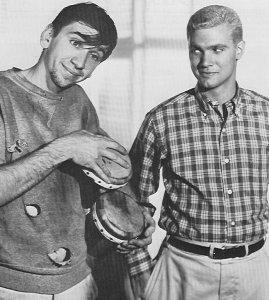
Maynard G. Krebs (Bob Denver) and Dobie Gillis (Dwayne Hickman)
It so happened that on that day I picked a random episode of Dobie Gillis for my wife and me to watch. I was too young to appreciate this TV show in its first run, but I remember my big brother watching it every week. Based on stories by Max Shulman, the show centered on a girl-crazy high school student (Dwayne Hickman) and his beatnik friend, Maynard G. Krebs (Bob Denver, pre-Gilligan). The show actually holds up quite well, via its quick cutting and sharp dialogue (and, if you look fast, appearances by early Tuesday Weld and Warren Beatty).
In this particular episode, it is discovered that Maynard has legit ESP. He can tell what people have in their pockets, what they are thinking, and even predict the future.
His gift is exploited by a local TV station, which brings Maynard on to demonstrate his powers in front of a panel of skeptical experts. Maynard proves his stuff. The station invites him back the next week in order to tell the world who is going to win the upcoming presidential election between Richard Nixon and John F. Kennedy!
Dobie tries to talk Maynard out of it. But for once in his life, Maynard is being treated with respect. The whole world is going to listen to him.
“Man, that’s like power,” says Maynard.
“Man, that’s like un-American,” says Dobie. “This is a democracy, Maynard! People have the right to vote for whoever they want. If you tell them who wins, people will stay home!”
Maynard is undeterred. On the night of the broadcast, Dobie stands outside the studio sending last, desperate thoughts to Maynard, who ends up doing the right thing. “Like, I don’t know!” he tells the host.
He’s unceremoniously tossed out of the studio. Dobie finds him and says, “Maynard, I’m proud of you! You’re one of the great Americans of all time. Paul Revere, Nathan Hale, Sergeant York, Barbara Frietchie…and my good buddy, Maynard G. Krebs.”
What struck my wife and me was how unapologetically patriotic Dobie was. How many high school students talk like that anymore? Who even knows who Nathan Hale was, let alone Barbara Frietchie?
Interesting that Dobie put that latter name on the list. Barbara Frietchie is the subject of a poem by John Greenleaf Whittier. The poem used to be taught in our schools. Kids would memorize it. I remember my dad reciting it. Based loosely on historical fact, it tells the story of an aged widow looking down from the attic of her house in Frederick, Maryland, as the occupying Confederate army, led by Stonewall Jackson, marches through. She sees them waving their flags, and puts out Old Glory on a flagpole. The soldiers shoot at it, shattering the pole. But Barbara grabs it and starts waving the flag herself. She shouts down at the soldiers the famous line:
“Shoot, if you must, this old gray head, but spare your country’s flag,” she said.
Whittier certainly embellished the facts, but so what? He was creating legend. As with Longfellow’s “Paul Revere’s Ride” the point was not realism, but idealism. Especially in context. “Barbara Frietchie” was penned during the Civil War; Whittier was a staunch abolitionist looking to inspire the North at a time when Lee and Jackson were beating the pants off it. A comment to an article on the background of the poem says it well:
The essence of “poetry” is not in detailed truths, but in the passions it appeals. Please don’t diminish yourselves by “seeking the truth/s of origin” in any poetry. Simply enjoy the story, the romance and the beauty of human actions.
In our fiction, we have that choice, too. Do we extol “the beauty of human actions” even through the most dire of circumstances? To Kill a Mockingbird comes to mind. So do my favorite thrillers.
And so does Dobie Gillis and all those family shows from the 50s and early 60s, like Leave it To Beaver. The standard criticism about those shows is along the lines of, “No families were really like that!”
Again, that misses the point. The shows were never intended to be cold reflections of reality. They were, first of all, entertainment. But they also carried positive, uplifting moral sentiments. In Beaver, for example, Ward would dispense essential wisdom to his sons. June would teach them to be polite, and how to behave in social gatherings. Wally would protect the Beav from the devilish whispers of Eddie Haskell.
In other words, these shows, as the old song puts it, accentuated the positive. Which is a good thing, in my view. Especially these days.
I’ve always liked this quote by writing teacher and novelist John Gardner, from a Paris Review interview:
I think that the difference right now between good art and bad art is that the good artists are the people who are, in one way or another, creating, out of deep and honest concern, a vision of life…that is worth pursuing. And the bad artists, of whom there are many, are whining or moaning or staring, because it’s fashionable, into the dark abyss….It seems to me that the artist ought to hunt for positive ways of surviving, of living.
What say you?
by James Scott Bell
@jamesscottbell
Early in my writing education, I read something about mystery and suspense that helped a great deal. The author said that a mystery was like a maze. The sleuth follows clues and red herrings, eventually getting to the answer.
But suspense is like a coil that gets tighter and tighter until the final SNAP.
You can have elements of both, of course, though which one predominates will determine your category.
Suspense is where I hang my keyboard, but almost always with a mystery attached. That’s why my favorite movie director is Alfred Hitchcock. Dubbed “The Master of Suspense,” Hitch wove tales that had you, as they used to say, on the edge of your seat.
I wish everyone could have the same experience I did when I saw Psycho for the first time.
It was in high school, and I’d never seen it, nor had I been informed about the plot. A friend of mine arranged for a showing in our high school auditorium one night before Halloween.
The place was packed.
The movie started, and there was Janet Leigh absconding with bank funds, and pulling in to rest at the Bates Motel.
Oh, man.
The suspense got tighter and tighter. The audience screams got louder, and loudest (me included) at the big reveal.
I shan’t tell you what that is, lest there be those unfamiliar with the film. (If this is you, you are lucky! Arrange to stream it when the sun is down and you won’t be interrupted!)
Books can be like that, too. The two scariest books I ever read are The Shining by Stephen King, and Helter Skelter by Vincent Bugliosi. The latter is nonfiction about the Manson Family, which lived in the hills about eight miles from my home. They made a miniseries about it which my roommates and I watched in college.
I had nightmares.
One morning I woke up to a scritch-scratch sound. I turned over and saw the guy I shared a room with, Doug, sitting on the edge of his bed, looking at me and sharpening a knife.
He got a big laugh out of that. Me, not so much.
By the way, if you want to know what that whole Manson vibe felt like, Quentin Tarantino captured it perfectly in Once Upon a Time in Hollywood. There’s a scene where Brad Pitt goes to the Spahn Ranch, where the family was holed up. It’s a fantastic scene and absolutely right on in the creep factor.
Tarantino made another alternative history about pure evil, Inglourious Basterds (spelling is correct). I’ve never seen a more suspenseful scene than this opening, where the Nazi played by Christoph Waltz interrogates a farmer who is hiding Jews under his house. Talk about a spiral that gets tighter and tighter. Yeesh!
I bring this up because I’m about to re-release the most suspenseful novel I’ve ever written. I had that coil firmly in mind as I wrote it, and kept making it tighter and tighter until…well, I best not reveal anything further. Except, if you’ll allow a bit of shameless self-promotion, this clip from a review:
“You’ve got mail” equals “You’ve got trouble” in this impossible-to-put-down thriller. Bell’s straight-from-the-headlines tale will raise the hair on your neck for one important reason: it could happen to any of us. Empowered by his firsthand knowledge of the legal system, the Christy Award-winning former trial lawyer paints a picture of just how vulnerable our secrets—and families—are, in the age of Internet stalkers. First-rate suspense with a fiery action-movie climax! – Christine Lord, CBD Reviews
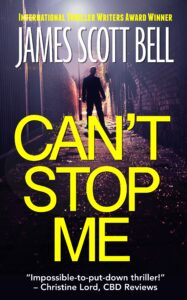 The title is Can’t Stop Me (formerly published as No Legal Grounds). As per usual, the Kindle version is up for the special pre-release price of $2.99 (regular will be $5.99). Go here to order.
The title is Can’t Stop Me (formerly published as No Legal Grounds). As per usual, the Kindle version is up for the special pre-release price of $2.99 (regular will be $5.99). Go here to order.
Outside the U.S., go to your Amazon store and search for: B0C6WGFBM1
Why do I lean into suspense? Maybe because I feel like the world is a tightening coil, where evil exists and does not sleep. We can either give in to it, or we can fight it; we just can’t ignore it. My fiction tries to work all this out. Isn’t that quest the basis of most dramatic action? From Homer and Aeschylus to John Grisham and Lee Child, the guiding light is justice.
What about you? Are you more mystery or suspense? Or something else? What does this tell you about you as a writer? I’ll be on the road this morning, but will catch up later. Have at it.
by James Scott Bell
@jamesscottbell
 Apropos of our discussion on Artificial Intelligence last week—and the horrifying prospect of millions of books being produced (not written) every year (one indie “writer” has declared he is going to produce ten books a month)—I thought I’d say a word on behalf of humanity. Goodness knows we need it.
Apropos of our discussion on Artificial Intelligence last week—and the horrifying prospect of millions of books being produced (not written) every year (one indie “writer” has declared he is going to produce ten books a month)—I thought I’d say a word on behalf of humanity. Goodness knows we need it.
I decided to corner the machine with a question. I asked ChatGPT itself if there was any room left for flesh-and-blood scribblers. It answered, in part,
AI can generate text based on patterns and data it has been trained on, but true creativity and originality often stem from human imagination, emotions, and experiences. Human writers bring a unique perspective and the ability to create innovative narratives that AI may struggle to replicate.
Fiction writing often involves exploring complex emotions and human experiences. While AI can analyze and mimic emotions to some extent, it may not fully comprehend the depth and nuances of human emotions in the same way as a human writer does. Emotional intelligence and empathy are vital components of storytelling that are challenging for AI to replicate convincingly.
Emotional intelligence and empathy. In other words, heart.
We gotta have it. It’s the thing that distinguishes us from the machines. And if we want to keep selling fiction, we need to get heart onto the page.
That’s because discoverability is a challenge with a “tsunami” of competent fiction deluging the Amazon shores. Some of that challenge is overstated. We’ve had 15 years of competent and mediocre ebooks, and it’s not volume that sells over time, or gives an algorithmic boost to a backlist. Reader reviews do much of the curation and the best books rise to the top (not always, as we know, but the odds are better with superb book after superb book).
Now, of course, the tsunami is exponentially bigger and more terrifying.
Or maybe it’s more like Sharknado!
What is the answer? Simply this: we have to put into our books what the machines cannot replicate. And the most important thing they cannot replicate is you. Your heart, your soul, your vision, pressed through the craft you diligently study and apply.
Robert Frost famously said, “No tears in the writer, no tears in the reader.” Meaning you’ve got to feel before you write.
You’ve got to write like you’re in love. Later, you can edit like you’re in charge.
Love, say the poets, is a kind of ecstasy that overwhelms. Even elementary school kids have ideas about love. Some time ago a teacher asked her class to define love. A few of the answers:
“Love is like a little old woman and a little old man who are still friends even after they get to know each other.”
“When somebody loves you, the way they say your name is different.”
“Love makes you smile when you’re tired.”
“You really shouldn’t say ‘I love you’ unless you mean it. But if you mean it, you should say it a lot.”
Tommy, age 6, nailed it: “Love is when a girl puts on perfume and a boy puts on shaving lotion and they smell each other.”
So, to love your book, smell it! By that I mean, don’t forget the sense of smell, as Steve recently discussed. But not just the obvious smell. Find something unique. Unique is what the machines don’t find. Yet.
Want to see what I mean? Look no further than the great Raymond Chandler in The Little Sister:
She smelled the way the Taj Mahal looks by moonlight.
No machine’s going to come up with that! Because it’s not rational, and it’s not meant to be. It’s meant to be felt.
Same with emotions. The machine will give you the obvious choices. Say your character is in a dark alley and hears footsteps. What emotion? Fear pops immediately to mind.
But that’s predictable. Instead, human, go deeper. In his book The Emotional Craft of Fiction, Donald Maass says to pursue “third-level” emotions. What this means is, you think of the obvious emotion the character would feel in a situation. But then ask, What else would the character feel? And ask once more, What else? That’s the third level, the one that is surprising, which a reader experiences as delight.
An exercise I love is the page-long sentence. I choose a moment in my story where the character is feeling deeply. I stop and open up a fresh doc and write a sentence of 200-300 words, no stopping, in the character’s voice, talking about all the permutations of the feeling, going on tangents, coming up with metaphors, not pausing to edit. Once you get going, your Boys in the Basemet will send up things you didn’t know were there, and you’ll get at least one gem to polish and put in your text.
Your heart is doing an end run around your conscious and cliché-steeped mind.
So let the machines churn their mediocre-if-competent product. Make yours unforgettable. The secret ingredient is heart.
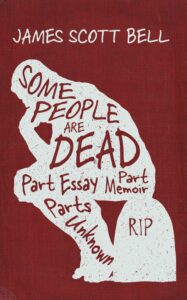 Speaking of which, I put a lot of my heart into a crazy book called Some People Are Dead: Part Essay, Part Memoir, Parts Unknown. These are short riffs on subjects—including my own life story—that arose randomly as I considered the obituaries of famous and not-so-famous people. These can be read as five-minute escapes from the world whenever such is needed (like, every day). The Kindle version is free for five days. Enjoy!
Speaking of which, I put a lot of my heart into a crazy book called Some People Are Dead: Part Essay, Part Memoir, Parts Unknown. These are short riffs on subjects—including my own life story—that arose randomly as I considered the obituaries of famous and not-so-famous people. These can be read as five-minute escapes from the world whenever such is needed (like, every day). The Kindle version is free for five days. Enjoy!
Over to you now. How do you get your heart into your pages?
We might as well end with the hit song from the musical Damn Yankees. In the song, heart is about grit, something else writers need in abundance, now more than ever: